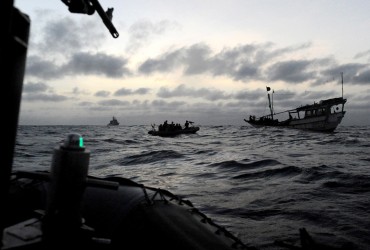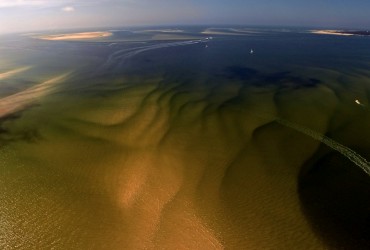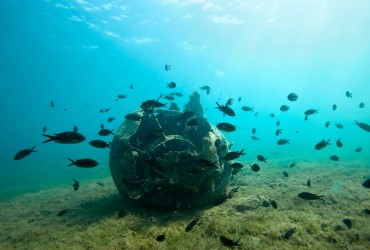The struggle against invasion
On their way to school on Friday 10th of October 2014, a group of students have to turn around and head back home. At Le Robert, on the island of Martinique in the Caribbean, an official decree instructs all the schools to evacuate and close down, until further notice. The reason? «Gas emanating from wash-up and decomposing Sargassum». Here, even the youngest pupils know what H2S means. The chemical formula of hydrogen sulfide is the main topic of conversation during each seaweed crisis. A school teacher deplores that it’s not the first time, neither the last, that her classroom has to be evacuated for safety reasons.
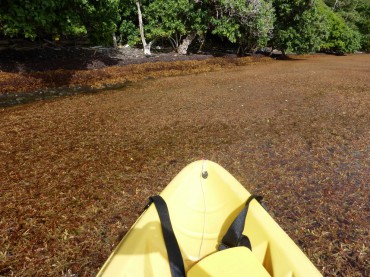 Not far away, the owner of the village’s kayak club is looking at his disfigured beach, facing another Sargassum invasion. Each time it is difficult for him to reach the water with his crafts, and worse, swimming is now unappealing and even advised against. Back on the mainland, tourists are thinking of cancelling their holidays with fear of having to spend a few weeks on an island that doesn’t offer the beautiful beach they have been dreaming of all year long …
Not far away, the owner of the village’s kayak club is looking at his disfigured beach, facing another Sargassum invasion. Each time it is difficult for him to reach the water with his crafts, and worse, swimming is now unappealing and even advised against. Back on the mainland, tourists are thinking of cancelling their holidays with fear of having to spend a few weeks on an island that doesn’t offer the beautiful beach they have been dreaming of all year long …
Didier Roux is responsible of the Health and Environment department at the Agence Régionale de la Santé (ARS) in Guadeloupe. He explains: «We consider these arrivals of seaweed as natural events, but on an exceptional scale. Once on dry land, the algae will ferment for a week or so, depending on the weather. During that time, a mix of three gases will be released: about half is methane, which is non-toxic and odorless, the other half is ammoniac, which is also non-toxic, and 0.6% is hydrogen sulfide. H2S is very poisonous, even in small quantities. It attacks the eyes and nose, and stinks of rotten egg.»
On the streets near the beach, there is an unusually large number of abandoned fridges, microwave ovens and various household appliances. Didier Roux sheds some light on this strange situation: «H2S is not only aggressive to living creatures, it also attacks electrical systems: it eats up copper, silver and other metallic compounds that can be found in printed circuit boards. As a result, many objects close to wash-up zones become useless. At first, the insurance companies paid for a replacement, but nowadays they refuse to compensate the people». Every week, the ARS personnel uses special detection devises to analyses 54 spots in residential and public parts of Guadeloupe. The measurements are then given to the prefecture. In case of a seaweed arrival on the coast, the ARS contacts the town hall to organize the cleanup. «We have calculated that the maximum human tolerance is of 10 to 12 ppm (part per million). It becomes really dangerous over 40 ppm. In the French Antilles, our measurements often reach 5 or 6 ppm, which is way below what could cause sickness. However, it’s not rare that people decide to move out because they are strongly and repetitively inconvenienced.»
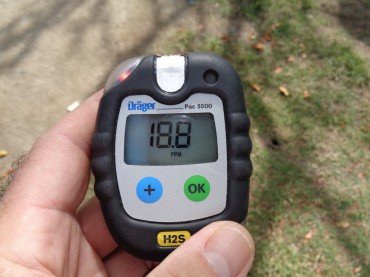 Some consider these massive wash-ups of stinking seaweed as a natural disaster, but not everybody agrees: «The French government is crystal clear on this subject. Because these arrivals of algae are regular and not sudden, they do not fit the criteria» says Roux. In the little town of Capesterre on Marie-Galante, which was severely touched in 2015, the people started a petition toward the recognition of the state of emergency for their situation. As to this day, their claim was not acknowledged by the authorities.
Some consider these massive wash-ups of stinking seaweed as a natural disaster, but not everybody agrees: «The French government is crystal clear on this subject. Because these arrivals of algae are regular and not sudden, they do not fit the criteria» says Roux. In the little town of Capesterre on Marie-Galante, which was severely touched in 2015, the people started a petition toward the recognition of the state of emergency for their situation. As to this day, their claim was not acknowledged by the authorities.
According to the biologist Franck Mazéas, there are approximatively 100’000 tons of Sargassum that reach the shores of the French Antilles annually since 2011. This quantity is extremely difficult to assess. In Didier Roux’s opinion, the amount of Sargassum to reach these islands is much larger than the amount of green seaweed that covers the shores of Brittany over the same period of time.
Nevertheless, the ARS asks the population to act with what little solution they have today. Didier Roux adds that «the victims can contact us through our phone center, and report the inconvenience related to Sargassum wash-up. We then assess the situation on location, and if necessary we can investigate. We work very closely with a network of sentinel physicians who report the pathologies related to the seaweed. Our surveillance system is effective. It’s hard to offer more, and today the best solution is to pick up the algae and move it elsewhere. It’s a daily struggle…»
During the first years, and as long as the concentrations were inferior to 5 ppm, volunteer work was organized with the local population. But it wasn’t a sustainable solution. The islanders had to wait the official visit of Ségolène Royale, French minister of ecology and François Hollande, French president, in May 2015 in order to see insurance funds be released, as well as public credits be allocated to the efforts of beach cleanups.
One of the concrete measures was the creation of the «green brigade». It is composed of workers paid at 90% by state budgets, and the other 10% by the ADEME, the agency responsible for the environment and the energy supply. Since November 2015, groups of several dozens of people take care of the wash-up zones. Equipped with masks, gloves and boots, they use spades and rakes to take the seaweed away in overflowing wheelbarrows. More than a 100 cleaners have been recruited in Guadeloupe for the manual work, which is the most ecological way to deal with the Sargassum. This small army is nevertheless often overrun by the scale of the events. It is a tiresome work, for the body and for the mind, when a beach is all cleaned up only to be recovered the very next day.
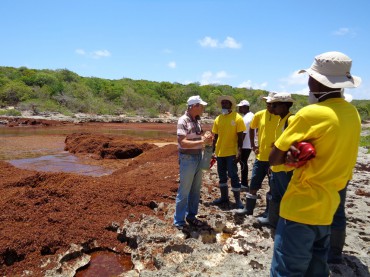 When the layer of seaweed is too thick, heavy machinery becomes necessary. Not only excavators or trucks are put to use, but even «cannopeurs» as the locals call them, first designed to be used in the fields to pick up the freshly cut sugar cane. They are easily maneuverable and wide enough to limit their impact on the soil. Unfortunately, many places that are covered in seaweed are impossible to reach with these vehicles, and even when they do they leave some kind of destruction in their wake: the beaches’ profiles are damaged, and the turtle’s nesting zones can be threatened.
When the layer of seaweed is too thick, heavy machinery becomes necessary. Not only excavators or trucks are put to use, but even «cannopeurs» as the locals call them, first designed to be used in the fields to pick up the freshly cut sugar cane. They are easily maneuverable and wide enough to limit their impact on the soil. Unfortunately, many places that are covered in seaweed are impossible to reach with these vehicles, and even when they do they leave some kind of destruction in their wake: the beaches’ profiles are damaged, and the turtle’s nesting zones can be threatened.
And even once the seaweed is properly picked up and carried away, comes the storage problem. What are the islanders supposed to do with such a large amount of decomposing and potentially harmful algae? «The public health council recommends to spread the seaweed in layers 10 to 15 centimeters thick, which allows its oxidation and not its fermentation, explains Didier Roux. Of course, this implies large areas not far from the beach, to limit transportation costs. After about 4 days, the dry layers pose no more risk of putrefaction and harmful gas. It is a fastidious task, and we need to brief the workers so that they spread the seaweed and not pile it up, in which case it would affect the nearby population».
Are the islands big enough to allow the spreading of such vast quantities of algae? The task seems to be too formidable to tackle. On the coasts of the Gulf of Guinea, the coastal communities also organize themselves in order to clean up their beaches. But local environmental NGOs deplore the fact that the new landfills often become repulsive zones where all the garbage is thrown away in the open. And it not only impacts the people, but the fauna and flora also pay a high price. «The mangroves are severely impacted, the grass beds are bleached, the bays become anoxic and the thick layers of Sargassum prevent the corals of photosynthesizing» observes Valérie Stiger-Poivreau, researcher at the CNRS. All of the ecosystem is prone to suffer: «We can even see the consequences on the coconut tree’s roots, which are dying due to the acidity of the soil where so much H2S is released», adds Didier Roux.
Damien Chevallier is a research engineer at the CNRS and he specialized in marine turtles. He says: «the Sargassum wash-up are posing problems to turtles at all of the stages of their lives. In Yalimapo, which is one of our study sites in Guyana, we can observe around 200 turtles on the beach every night of the egg-laying season. When the sand is covered in Sargassum, we don’t see 200 turtles anymore, but one or two who desperately try to find their way up the beach. Our studies have shown that turtles are strong linked to their laying spot, and if they cannot reach it, which is usually the case because of the Sargassum, their eggs are expulsed in the water. In which case the next generation is doomed».
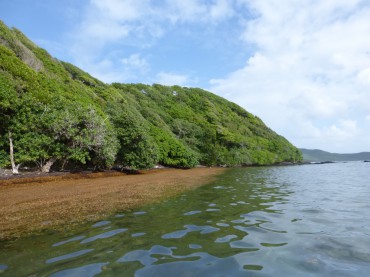 If the Sargassum covers the sand between the hatching of the young turtles and their emergence, they have virtually no chance of digging their way through a thick layer of impenetrable seaweed. Recently in Barbados, around 40 turtles of all ages were found dead trying to leave the nesting grounds, trapped or asphyxiated by the seaweed. Since 2011, From Guyana to Mexico, all of Central America is threatened. The worst episodes happened in 2014 and 2015, with such an impact that the scientists witnessed a drop in the demographic. In the Antilles, the green and hawksbill sea turtle seem to be the two species that suffer the most. «As if the Sargassum problem was not enough, poaching and pollution are also a big threat. We fear for the future of these two species” says Damien Chevallier. In Guyana, one of the solution would be to put up artificial hatcheries. But the researcher says that «we would need to pick up the eggs one by one, and then release the hatched younglings in the sea. The logistics and infrastructure for this kind of operation are substantial, but I am confident we will be able to unlock funds. It’s a matter of survival for these species».
If the Sargassum covers the sand between the hatching of the young turtles and their emergence, they have virtually no chance of digging their way through a thick layer of impenetrable seaweed. Recently in Barbados, around 40 turtles of all ages were found dead trying to leave the nesting grounds, trapped or asphyxiated by the seaweed. Since 2011, From Guyana to Mexico, all of Central America is threatened. The worst episodes happened in 2014 and 2015, with such an impact that the scientists witnessed a drop in the demographic. In the Antilles, the green and hawksbill sea turtle seem to be the two species that suffer the most. «As if the Sargassum problem was not enough, poaching and pollution are also a big threat. We fear for the future of these two species” says Damien Chevallier. In Guyana, one of the solution would be to put up artificial hatcheries. But the researcher says that «we would need to pick up the eggs one by one, and then release the hatched younglings in the sea. The logistics and infrastructure for this kind of operation are substantial, but I am confident we will be able to unlock funds. It’s a matter of survival for these species».
The small islands in the Antilles are all confronted to the same problems, and are coming up with very costly solutions. But not all of the countries hold the same financial powers as the French and the Americans. Some think that an international cooperation should be set up towards the common goal of fighting the disaster. Moreover, the Cartagena Convention in Colombia, which was signed in 1983 under the United Nations Environment Program (UNEP), is there to protect and enhance the marine world of the Caribbean. «In December 2014, the Sargassum invasion was inscribed on the 2015-2016 protocol’s work agenda for the Specially Protected Areas and Wildlife (SPAW)» is what can be read on the DEAL website.
In August 2015, Hilary Beckles, vice-chancellor of the West Indies University, announced that an estimate 100 million euros and 100’000 workers would be necessary to clean up the Antillean coast. He asked for the creation of the Sargassum Emergency Agency. No state has since answered his call. On the other side of the Atlantic, in the Gulf of Guinea, we can only imagine the difficulties the communities will have to face considering the local political context.
Damien Chevallier does not mince his words: «We need an international agreement with Brazil, and fast. It is in everyone’s best interest to find long lasting solutions to this plague that is harmful to the health, the environment and the economy. It may seem utopic, but I believe we can solve the problem at its source. For that, Brazil needs to make firm commitments with the international community. However, it doesn’t mean that in a hurry, we must forget to look into the valorization of the Sargassum out at sea, and its other positive impacts». It is clear we need to adapt to this new paradigm instead of fighting against its consequences. At least, this is the message we received by most of the scientists during our investigation.

